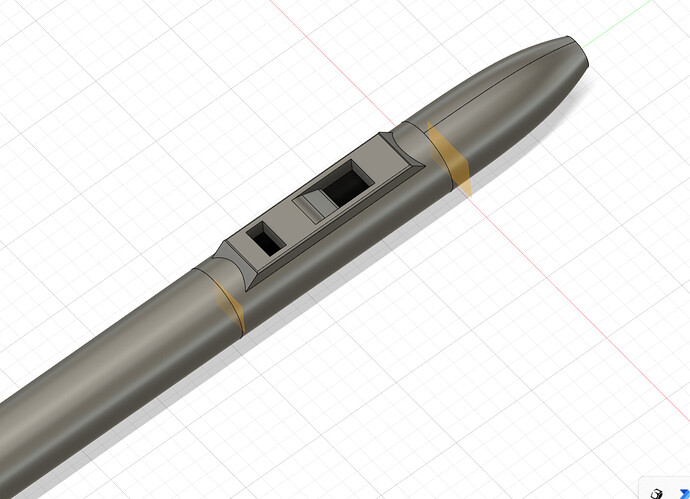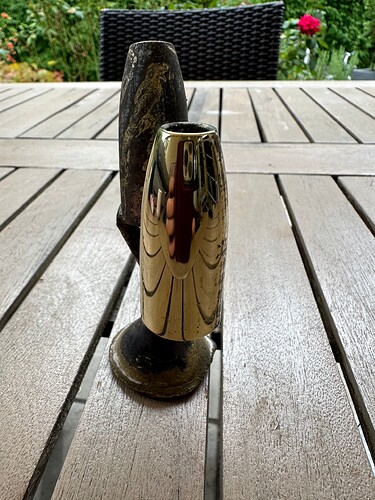Dear All,
I am new to this forum and I hope my “not 100% jewelry-related” subject is ok.
I have been building Native American style flutes made out of wood for some time now. I recently came up with the idea of making one completely out of silver. I am obsessed with the idea and started to get equipment and practice lost wax casting because I am planning to cast some delicate parts of the flute. I have set up a blog on which I am tracking my progress and would be very happy to get some feedback because I have NO experience with metal / silver casting and some hints would be great.
Here is the page: Silver Flute Blog - Crafting the Native American Style Flute
One of my current questions is how to optimally attach the part (in this case the mouthpiece) to the sprue. You will know what I mean if you look at the page. Is it better to attach the piece directly to the sprue at one location or to create multiple thinner channels from the sprue to the part?
Thank you very much for your help in advance
Kay
1 Like
Hello there. I would DEFINITELY suggest using a casting house. I’d get in touch with them now and use their knowledge and guidance to ensure success.
The carving and design of the flute in wax is already quite a remarkable feat - learning to cast silver can be expensive and frustrating. I know because I’m doing it and simple small items like rings are hard enough.
I would LOVE it if you’d post updates because that sounds like a really cool project.
Good luck!
1 Like
I just checked out your blog - I guess you’ve already dove into casting lol! Welcome to the madness. All in all, since you’re just casting a few parts I’d definitely use the search function on the forum and read all the threads on silver casting and sprueing.
1 Like
Thanks for your feedback. I know a casting house would have been easier and cheaper but I like to learn the hard way  which will also have the benefit of having the right tools and know-how to possibly cast some jewelry which I would also enjoy. And yes … I will read all forums and watch all videos I can find in the next days/weeks. Most people discuss rings which is very close but I feel the shape of the flute parts might require a slightly different handling.
which will also have the benefit of having the right tools and know-how to possibly cast some jewelry which I would also enjoy. And yes … I will read all forums and watch all videos I can find in the next days/weeks. Most people discuss rings which is very close but I feel the shape of the flute parts might require a slightly different handling.
2 Likes
I’m just like you in wanting to get the experience over the easy path, so I understand. The information about sprueing should translate. It’s all just the physics of metallurgy.
You can definitely use casting bronze to practice. Which is much less expensive. Also, you can make silicon molds of carved waxes before casting if you want to.
1 Like
I read your blog. Right at the top you said you wanted to make a flute out of pure silver. Do you mean pure silver as in find silver or are you referring to sterling silver? I don’t advise making it out of fine silver. You must go with Sterling. Find silver would be too soft. You could do it, but it wouldn’t hold up well.
2 Likes
You are absolutely right. I will use Sterling Silver and I have changed the blog accordingly.
Thanks for the hint!
1 Like
Can you post a picture here on the forum of what you’re trying to create? Even a wood version flute. The images on your blog are kind of small. That will help us help you.
Thanks!
Jeff
1 Like
Thanks for your help! Attached you can see a slightly simplified picture of the flute. My plan so far is to cast the mouthpiece, the sound producing area with the rectangular holes, use a silver tube for the “rest” and solder them together.
A picture of one of my wooden flutes:
Best Regards
Kay
2 Likes
That sounds accomplishable. Once you have made the wax models of those components, the most complicated aspect in casting will the center cores. Assuming that you’re doing traditional lost wax jewelry casting you’ll have a brittle center core of investment plaster that can easily break off and float around messing things up. Based on looking at the images and what I think the size is that you’ll be okay, but you never know.
You can put stainless steel wire pins through both sides of those tubular shapes to help anchor the cores, but then you’ll have to drill them out of the cast silver and patch the holes which is a fair amount of extra work. It’s probably best to cast the components without core pins and know that’s a possibility for future tries, if the cores break off.
Best of luck and thanks for sharing the images!
Jeff
1 Like
Hi Jeff,
thank you for your hints! I will try the steel wire pin idea if necessary and keep you posted!
Best Regards
Kay
1 Like
When casting objects with a center core that might break off, You make small holes in the wax or resin model at the proper location to support the inside. The investment plaster in those holes makes little pillars for support. After casting, you fil those holes with metal.
I’ll just jump here are a musician and a jeweler, yes sterling silver is the way to go, they will be stronger and the tone sweeter. Yes, use a casting house for the cast parts, look for one that has experience casting larger sterling pieces. For the soldering together, I recommend a product called Stay Bright, its a low temperature silver bearing solder.
Now I did see you already bought the tools for lost wax casting, well go ahead and experiment!
I am also worried the little torch you have might not be strong enough and have a big enough flame…maybe look into getting a Hoke torch?
1 Like
Hi jojohollister,
cool that you are also interested in both “arts”: music and making jewelry. To me, this is currently a beautiful combination of two passions (music and crafting) of mine. I can’t wait to hear the tone when it is done.
The little torch was perfect a while ago when I started to practice soldering some small rings. For the flute parts and also possibly to support heating while pouring the silver, I will get a bigger one. Thanks for the link. I will probably get the one you suggested.
Have a great day
Kay
1 Like
Thank you all for your tips/tricks. My latest attempt to cast the mouthpiece in bronze worked out pretty well. I am not sure if the discoloration tells any professional out there if I could have done anything better but so far I am happy. As far as I can tell, I really don’t need multiple flow channels.
2 Likes
Thank you all for your tips/tricks. My latest attempt to cast the mouthpiece in bronze worked out pretty well. I am not sure if the discoloration tells any professional out there if I could have done anything better but so far I am happy. As far as I can tell, I really don’t need multiple flow channels.
2 Likes
Just a question about the musical difference between casting and drawing metal. At North Bennett Street School I had a classmate who owns a flute factory in
Boston. They cast flutes and made the heads differently for how the player wanted it to sound. So rose gold or even titanium for different acoustic needs.
1 Like


